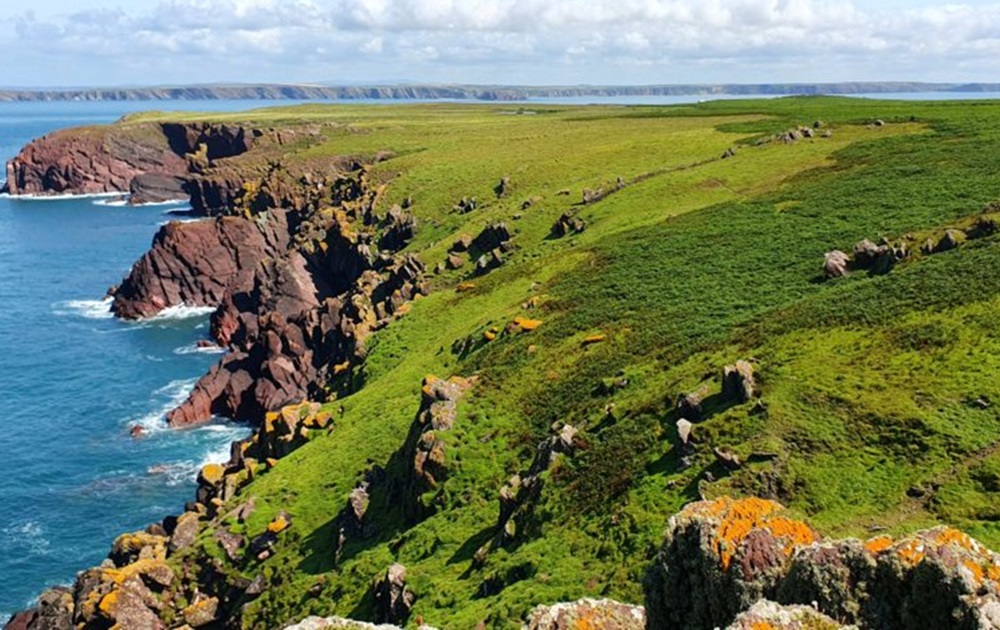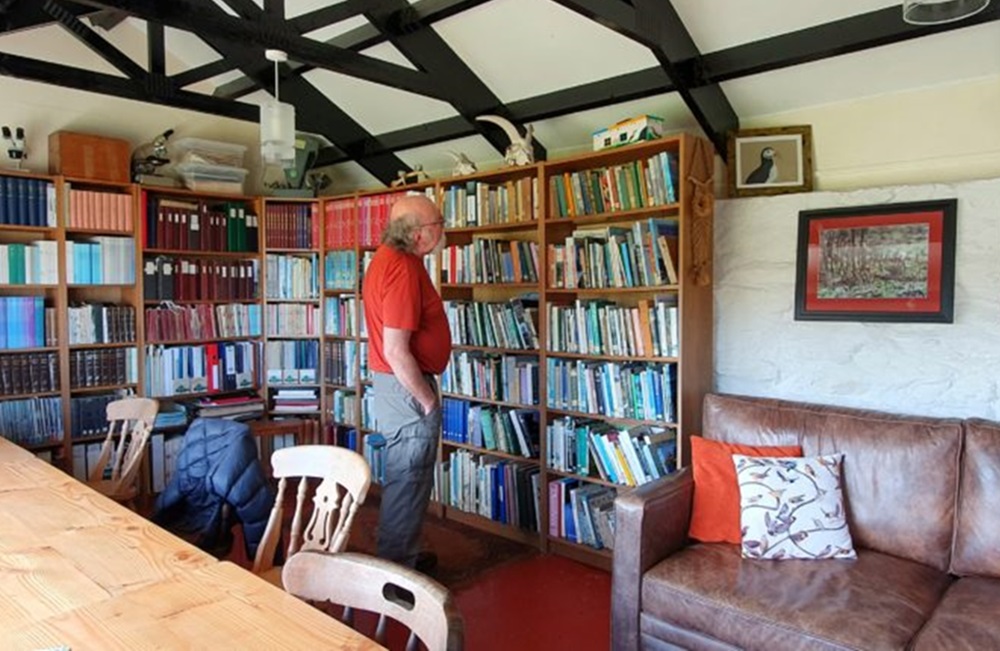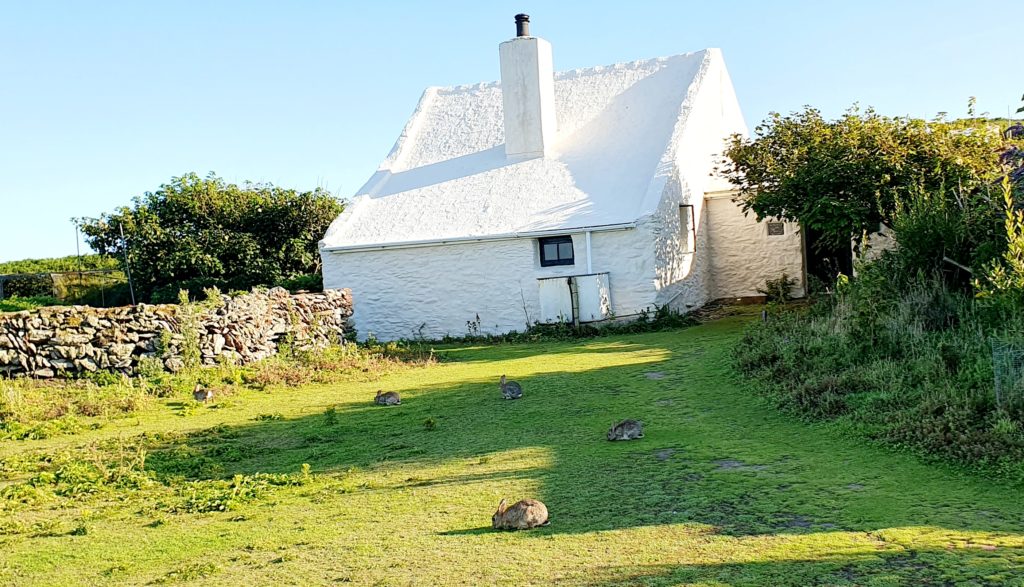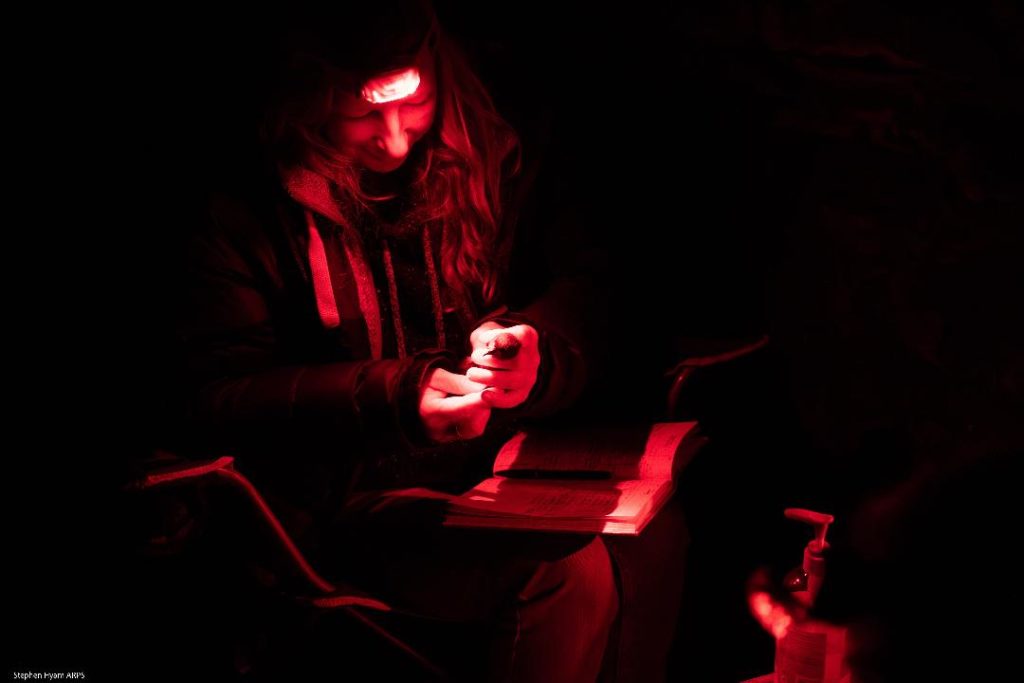A Letter from Skokholm

Catherine Duigan
The island of Skokholm has long been a stepping stone for the movement of people along the coast and between Wales and Ireland, with its name reflecting a period of colonisation by Scandinavian invaders. Today trees are largely confined to the shelter of walls, but Skokholm is thought to be Norse for “wooded island”. Time can still be measured by the daily passage of the ferry between Pembroke Dock and Rosslare.
My breakfast was secured after some diplomatic waltzing around my companions in the well-equipped communal kitchen. Then I set off towards The Neck following the white stones on the edge of the dusty paths of pulverised Old Red Sandstone, the island’s foundation.
Rabbits
The vegetation on Skokholm is a tapestry of texture and colour woven by the wind, salt spray, and the activities of the birds and rabbits. Present as far back as the early 1300s, the rabbits are everywhere. Betraying their domestic origin, some are standard brown, others black and a few have white bibs. The rabbits also provide a vital living labyrinth of nesting burrows for the thousands of puffins and Manx shearwaters using the island.
On the way to the bird hide, I recognised some of the distinct plant zones described by Aberystwyth University botanist, Mary Gillham. Almost shoulder-high bracken fronds obscured two broad field walls, revealing that Skokholm was once managed as a farm by Ronald Lockley, who also established it as the first bird observatory in Britain. An open area was dominated by free standing clumps of ragwort and thistles, with intertwining colourful cushions of violets, white sea campion and scarlet pimpernel.

Puffin season
Although it was very late for the high drama of puffin season, a few brave parents continued to dodge the marauding gulls to deliver beaks full of glistening sand eels to the pufflings waiting in the burrows. One adult took a quick tour of several burrows looking for its chick, or perhaps sneaking a cheeky peek into nest real estate which might be available next summer.
At lunchtime Warden Giselle Eagle reflected on the impact of bird flu on Skokholm’s seabirds. In 2023 one guillemot chick was noticed dead on a ledge but it could not be retrieved for testing. This was quickly followed by the catastrophic Pembrokeshire bird wreck with hundreds of dead birds washing up on local beaches. The following year 200 guillemots were missing from the same Skokholm ledge. The total count is back to normal expectations now, but largely due to increases in other parts of the island.
Being caught in a rain shower in the afternoon was the excuse to retreat to the bright, comfortable library. Its comprehensive collection of bird books, field guides and literature about the island is a very important research resource for visitors and ecologists supporting the work of The Bird Observatory. From Peter Scott to Peter Hope Jones, generations of ornithologists overlap in the historic Visitors Book. There are long standing connections to Oxford, Cambridge and several Welsh Universities. Consistent environmental records for this isolated island extend back almost one hundred years making them a very important reference in our changing world.

Observations
At 9 o’clock, with laptop and notebook, Warden Richard Brown appeared on the steep stairs through the hatch door in the ceiling of the living room in the farmhouse. About twenty of the island’s residents had assembled to contribute their wildlife observations from the day. Sitting in the glow of the screen in the corner of the room, Richard began his long list of species, starting with the birds – fulmars, shearwaters, cormorants, shags… – but also including other animal groups, such as butterflies and moths.
Over 200 puffins were counted in an offshore raft at The Neck and there were 19 seals in the South Haven. It was the first day post breeding season that guillemots were not recorded. We were also reminded to look out for common mainland species, such as magpies, which only occasionally venture over from the mainland.

Ringing
Richard invited us to take part in the storm petrel ringing starting after dark, with a warning to carry our head torches in our hands to minimise collisions with the Manx shearwaters who surrounded us with their ghostly hoarse gurgling laughs.
The embayment in the lime kiln had been turned into a red-lit avian grotto. The four bird ringers were organised around a small weathered wooden table: one sitting in the centre, with the others crouched on either side. Their tools were laid out – pliers, flatbed weighing scales, callipers and a string of small metal bands with unique numbers.
Carrying fragile cargo in individual white cloth bags, Richard periodically emerged from the blackness where the mist nets had been set up. First, the bird was checked for a leg band and ringed if required, body and wing length were measured and with a confident wrist twist the little bird was turned bottom up into the constraint of a small plastic pot to be weighed, with an average of only 26 grams.

Precious petrel
A precious storm petrel was transferred into my waiting hands. My first two righthand fingers were carefully placed on either side of its neck gently restricting forward movement, cupping the remainder of the body and wings with both of my hands. Making my way slowly over uneven ground and out of the circle of light, I found the safe release area.
For a sublime moment, you can free the petrel’s delicate body on the top of the harbour wall, and it remains with you in the shelter of your fingers. Suddenly a flicker – it disappears into the darkness over the glittering Irish Sea. Will this “swallow of the sea” ever be held in a human hand again?
Lockley wrote his classic “Letters from Skokholm” (1947) to his friend and brother in-law, John Buxton, held captive as a prisoner of war during World War Two. Although he recognised the critical moment in history, he decided to make only factual observations on the natural history of the island. As we face politically unstable times today, with war returning to Europe, we are very fortunate to be able to continue to find nature, peace and inspiration in Skokholm.
You can keep up to date with island developments on The Skokholm Blog and in the Skokholm Bird Observatory Annual Report. Information for planning a visit is available from the owners of the island, The Wildlife Trust of South & West Wales
Support our Nation today
For the price of a cup of coffee a month you can help us create an independent, not-for-profit, national news service for the people of Wales, by the people of Wales.




